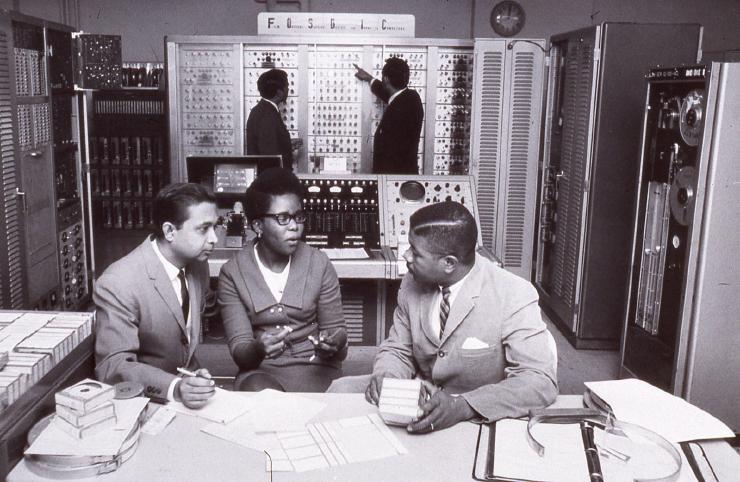
Computer programs have long been used for research purposes. The header image shows U.S. Census Bureau employees using the Film Optical Sensing Device for Input to Computers (FOSDIC) for census data translation and storage. Read more about FOSDIC history here. Image attribution: U.S. Census Bureau employees, Public domain, via Wikimedia Commons.
This post is part one in a series of in-progress research updates from the USER team. Stay tuned for more!
In November, we began an exciting new project funded by the Sloan Foundation. We’ve named it “USER” — short for Usable Software Ecosystem Research – a research initiative that explores how open source scientific and research software (S&R OSS) teams understand, consider, and undertake usability and design opportunities in their projects. We at Superbloom have dedicated ourselves to understanding and sharing how designers work and how design is practiced within open source teams and communities for years (see Open Source Design and our podcasts on Sustaining Open Source Design), but the USER project presents a new opportunity for us to dig into these questions within academic and scientific communities in particular. It’s also an invitation to reflect on our own experiences of doing design and usability work across the open source software (OSS) ecosystem.
Science and research communities have plenty of overlap with other OSS tools and projects we’ve worked with in the past, but they also present unique perspectives and challenges around sustainability and design in open source. To begin, we completed a solid month of desk research and an ecosystem scan. We familiarized ourselves with relevant literature on design, usability, OSS, and scientific software, and started compiling a database of people and projects to map the diversity of the S&R OSS world. We plan to publish an ecosystem map with our other outputs later this year.
While the USER research team delved into the papers, blogs, repos and written accounts of key terms and subjects, we also made social connections with key S&R OSS funders, projects, institutions and individuals across conferences and community events like CZI Open Science and OpenRIT. We’ve learned from past design research projects in OSS that important context and nuance is revealed through relationship building, so establishing these connections contributed to our exploratory research practice. Developing an understanding of and learning to participate in the culture and community of OSS, not unlike how OSS itself gets built and maintained, comes from connecting with other people who value the work. From these connections, we built relationships that fed the research activities and also allowed our design researchers and the scientists, researchers and designers we met to speak on equitable, social terms and gather initial human-centered insights.
Our research and outreach at conferences helped to inform preliminary findings and hypotheses, creating the foundation for our published survey. We invited the project contributors we’d met in person and those we’d identified in our ecosystem research to participate, and shared in communication channels and email lists frequented by communities of interest. While this online survey collected responses from the science and research open source community at large, we were simultaneously creating our Interview Guide collaboratively between 4 team members. Our interview script ended up at 32 questions total across 5 key themes, intended to be semi-structured and adaptable to a given conversation with a participant. Needless to say, with each participant we could have done many more interviews, as there was so much to talk about across these key themes - If only time permitted and interview fatigue wasn’t something we and our participants battled with!
In December, we started conducting interviews and we’re wrapping them up in February 2023, and are expecting to end up with 25-30 interviews. We have been speaking with a broad range of maintainers, developers, designers, scientists, researchers, funders, OSPOs and stakeholders – anyone who is involved with creating and maintaining open source scientific & research software. The Interview Guide sought to gain further insight into:
- How norms in academic, science, and/or open source working environments affect the choices teams make around their users and different kinds of design interventions.
- How team dynamics and trust affects those choices.
- What teams would need to be interested in or able to prioritize usability and design in their work.
These activities so far – ecosystem research, conference attendance, the survey, and interviews – have exposed us to a diverse network of programmers, community managers, stakeholders, and designers who all contribute to the S&R OSS space. These people are volunteers, full time academics, government employees, students, and more. We’ve learned so much from them, not only about how science and technology meet, merge, and occasionally clash in software projects, but about how communities of users and contributors dedicate themselves to writing documentation to improve usability and accessibility, how the sustainability of OS projects shifts across contexts and institutions, and what scientists and designers need to understand better about each other. We’re so excited to be moving into our synthesis phase this week, and we will share more preliminary themes and findings as we work.
Keep an eye on our blog and on our open repo for further updates! Also, feel free to reach out to us at [email protected] if you would like to learn more about this work.
Credits
Project Contributors: Eriol Fox, Katie Wilson, Susan Kennedy, Ngọc Triệu, Jan Dittrich
With support from the Sloan Foundation.
Tags
Open source, usability, research